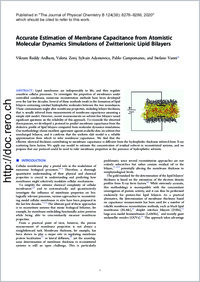Accurate estimation of membrane capacitance from atomistic molecular dynamics simulations of zwitterionic lipid bilayers
- Ardham, Vikram Reddy Chemin du Musée 10, Department of Biology, University of Fribourg, 1700 Fribourg, Switzerland
- Zoni, Valeria Chemin du Musée 10, Department of Biology, University of Fribourg, 1700 Fribourg, Switzerland
- Adamowicz, Sylvain Chemin du Musée 10, Department of Biology, University of Fribourg, 1700 Fribourg, Switzerland
- Campomanes, Pablo Chemin du Musée 10, Department of Biology, University of Fribourg, 1700 Fribourg, Switzerland
- Vanni, Stefano Chemin du Musée 10, Department of Biology, University of Fribourg, 1700 Fribourg, Switzerland
-
24.09.2020
Published in:
- The Journal of Physical Chemistry B. - 2020, vol. 124, no. 38, p. 8278–8286
English
Lipid membranes are indispensable to life, and they regulate countless cellular processes. To investigate the properties of membranes under controlled conditions, numerous reconstitution methods have been developed over the last few decades. Several of these methods result in the formation of lipid bilayers containing residual hydrophobic molecules between the two monolayers. These contaminants might alter membrane properties, including bilayer thickness, that is usually inferred from measurements of membrane capacitance assuming a simple slab model. However, recent measurements on solvent-free bilayers raised significant questions on the reliability of this approach. To reconcile the observed discrepancies, we developed a protocol to predict membrane capacitance from the dielectric profile of lipid bilayers computed from molecular dynamics simulations. Our methodology shows excellent agreement against available data on solvent-free noncharged bilayers, and it confirms that the uniform slab model is a reliable approximation from which to infer membrane capacitance. We find that the effective electrical thickness contributing to membrane capacitance is different from the hydrophobic thickness inferred from X-ray scattering form factors. We apply our model to estimate the concentration of residual solvent in reconstituted systems, and we propose that our protocol could be used to infer membrane properties in the presence of hydrophobic solvents.
- Faculty
- Faculté des sciences et de médecine
- Department
- Département de Biologie
- Language
-
- English
- Classification
- Biological sciences
- License
- License undefined
- Identifiers
-
- RERO DOC 329620
- DOI 10.1021/acs.jpcb.0c03145
- Persistent URL
- https://folia.unifr.ch/unifr/documents/309115
Other files
Statistics
Document views: 61
File downloads:
- van_aem.pdf: 265
- van_aem_sm.pdf: 84

